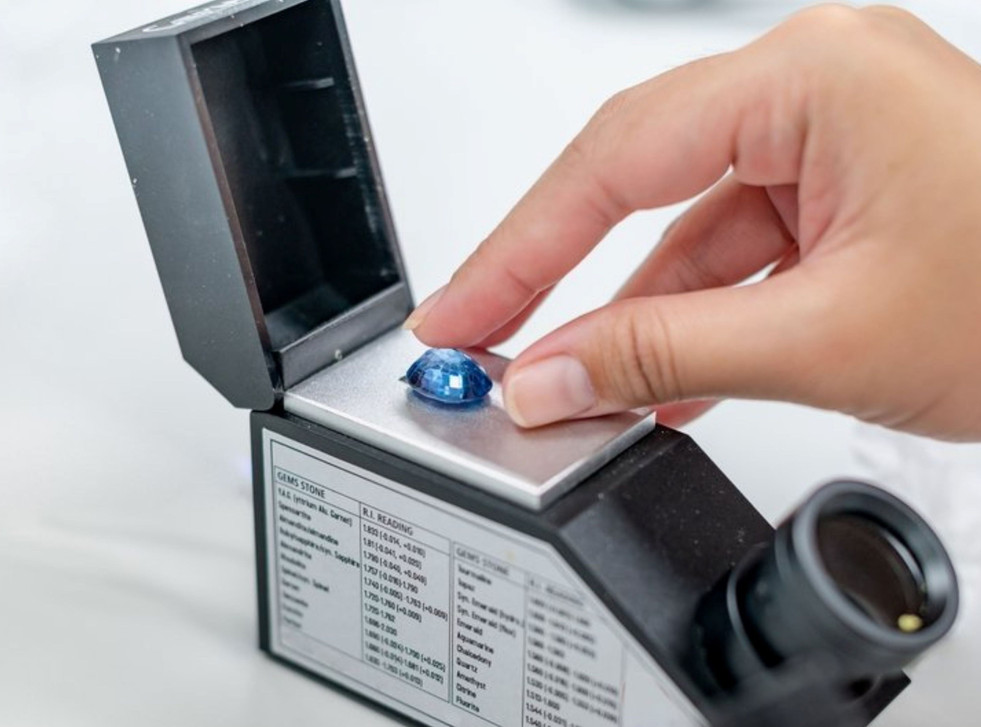When a gemstone is presented for appraisal, the jeweler will need to determine for sure what the gemstone is and if it is natural or fake, or treated or dyed, without actually harming the stone. The Mohs scratch test can tell the jeweler the hardness of the stone, but most likely the jeweler won’t want to risk scratching the stone. So, testing of the stone is limited to optical and physical measurements. Some stones are so distinctive that they can easily be identified with a visual examination.
While color can help the jeweler narrow down the list of what the gemstone may be, color itself is not a definitive identifier. Color variations and also inclusions are not always visible to the naked eye. So, most jewelers will start with an 10x power loupe, an Opti visor, and/or a minimum 40x power microscope to examine the stone more thoroughly. Sometimes color, matrix, or even inclusions can help identify the location the gemstone came from! Often inclusions can identify if the stone is synthetic or fake. Synthetic gemstones often have internal characteristics that will give them away. Verneuil-grown synthetic stones display curved growth lines and round bubbles are usually a sign of a synthetic stone or glass.
Refractive index is usually a useful measurement. It is measured using a Refractometer, which provides a numerical value indicating how much light is refracted. The refractive index in gemstones measures how much light bends when it enters the stone. Different gemstones have varying refractive indexes. For example: Diamond: ~2.42, Sapphire: ~1.76 - 1.77, and Quartz: ~1.54 - 1.55. A higher refractive index generally indicates greater brilliance and fire in a gemstone, affecting its visual appeal and its value.
Specific gravity is another important measurement for gemstones. The specific gravity of a gemstone is determined by seeing whether the gemstone sinks, floats, or is suspended in a liquid with a known specific gravity. Specific gravity is then calculated by dividing the weight of the gemstone in air by the weight of an equal volume of water. Common gemstones have specific gravities ranging from about 2.5 (e.g., quartz) to over 5 (e.g., diamond).
Another thing jewelers look for is fluorescence. Fluorescence in gemstones refers to the phenomenon where certain stones emit visible light when exposed to ultraviolet (UV) light.
Pleochroism in gemstones is detected using a polariscope and/or a dichroscope. A polariscope helps determine the optical properties of gemstones by using polarized light to reveal whether a gemstone is isotropic (single refractive index) or anisotropic (multiple refractive indices). A dichroscope allows gemologists to see how a gemstone displays different colors when viewed from different angles. This tool is particularly useful for identifying certain types of gemstones, such as tourmaline and iolite, which exhibit distinct color variations.
The spectroscope reveals the wavelengths of light emitted, or reflected, from a gem. The absorbed wavelengths of light will appear as a darker shade of color or black. Since some absorption patterns are distinctive, they prove useful for gem identification. In some cases, only a spectroscope can detect if a gem’s color is natural, dyed, or irradiated.
Stayed tuned new month as we will learn about the measurements used when dealing with gemstones!
 US Dollar
US Dollar
 Australian Dollar
Australian Dollar
 Euro
Euro
 Canadian Dollar
Canadian Dollar
 British Pound Sterling
British Pound Sterling

